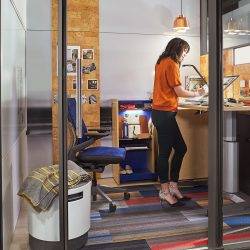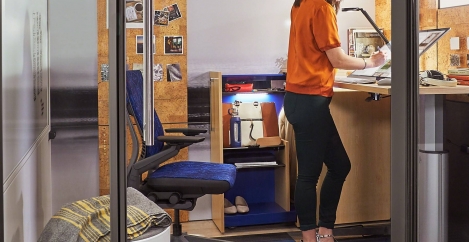November 19, 2020
Six key factors of productivity for organisations disrupted by lockdown
 With a new national lockdown, the situation in the UK remains unpredictable and complicated, and renewed pressure to work from home has forced many organisations to reverse their back-to-work plans, according to a new study from Advanced Workplace Associates (AWA). The study has detailed the matrix of pain that employees may be suffering due to this challenging situation – from those who didn’t want to return to the office when restrictions were eased but had to, to those who are unhappy about working from home. In creating unhappy, disengaged employees, these pain points undermine the six key factors of productivity, defined by the AWA as: social cohesion, trust, perceived supervisory support, information sharing, vision and goal clarity, and external communication.
With a new national lockdown, the situation in the UK remains unpredictable and complicated, and renewed pressure to work from home has forced many organisations to reverse their back-to-work plans, according to a new study from Advanced Workplace Associates (AWA). The study has detailed the matrix of pain that employees may be suffering due to this challenging situation – from those who didn’t want to return to the office when restrictions were eased but had to, to those who are unhappy about working from home. In creating unhappy, disengaged employees, these pain points undermine the six key factors of productivity, defined by the AWA as: social cohesion, trust, perceived supervisory support, information sharing, vision and goal clarity, and external communication.
To combat this, says Steelcase, workplaces need to focus on supporting employees as they continue to work from home, providing strategies that cater to each of these six factors. By catering to mental, emotional, and social needs, organisations will not only be able to improve employees’ wellbeing and boost productivity, but also create and maintain a strong culture while working remotely.
Social cohesion
Work is an inherently social activity, so it is no surprise that employees are suffering when they are unable to interact with one another in a physical workspace. Rather than relying on cohesion by default – the unplanned conversations and connections people experience by virtue of existing in the same space – organisations now need to actively and deliberately build belonging among remote teams.
Becoming isolated from colleagues means that individuals need more social checkpoints to continue feeling like part of a team. This could be achieved by scheduling virtual coffee meetings and catch-ups, or setting aside time at the beginning or end of a meeting for informal conversations. For more continuous support, a group chat for social interactions helps to boost happiness and strengthen the connections between team members.
Trust
Without visual contact between co-workers, it is a lot more difficult to understand what they are working on and their availability – which can, unfortunately, erode trust. To work successfully, employees need to trust their colleagues, and feel trusted in turn, especially when everyone is suffering increased stress due to the coronavirus pandemic. The best way to achieve this trust is through transparency.
Let colleagues know when you’re not going to be at your desk or computer – both on a daily and ongoing basis – to enable reasonable expectations and prevent distrust. When both employees and leaders are as open as possible about their schedules, stresses, and interruptions, it helps to build a culture of trust and allows people the space and psychological safety to perform at their best.
Perceived supervisory support
Employees need to feel like they are supported, heard, and understood by their supervisors, and this does not come as naturally when they aren’t in the office. Nevertheless, there are ways to make virtual interactions more meaningful. For example, using video calls rather than voice calls allows participants to read facial expressions and pick up on body language cues, while also reassuring colleagues that they have your full attention. Team leaders should champion authenticity, sharing their own struggles so that individuals know they have room to be fallible too – and can voice any worries they have
Information sharing
Teams who are working remotely often fail to communicate as effectively as they would in the office, and need to be more intentional about sharing information to keep everyone on track. Consistent connections – such as a daily or weekly video call – are essential to avoid silos and prevent isolation. This also provides employees with the opportunity to voice concerns before they become overwhelming.
These concerns may not just be related to tasks or projects. To create a culture of wellbeing, it is particularly important to encourage employees to communicate if their workspace isn’t working for them, and work together to figure out how to make it better – whether they need an ergonomic chair or to get a change of scenery for a couple of days a week
Vision and goal clarity
People are more productive when they can see that their work matters, and that it is building towards something. This is even more important when employees are isolated, but technology can step in to encourage alignment and boost motivation. Introducing a virtual project board will make teamwork visible online and ensure that everyone is working toward a common goal.
On an organisation level, it is extremely important to communicate clearly about your response to government guidance – which may not be easy to understand – and your return-to-office plans – no matter how long-term these might be. Knowing where you’re heading as a business, even if these plans have to change, keeps employees motivated and on-task.
External communication
At the best of times, specific teams or entire organisations can suffer from a lack of external ideas, and mass-scale working from home can make work more insular than ever before. Employees want to experience the views of diverse groups outside of their teams, but without the possibility of attending external meetings or in-person events, this can seem difficult to facilitate.
However, like many other elements of life, these events have pivoted to allow for virtual participation. There are a wide range of online webinars and conferences going on – with the added bonus of being able to attend events across the world. Encourage employees to sign up for these events, and allow them the space and time they need to do so. If possible, invite external participants to team calls to bring in a fresh perspective.
Image: Steelcase/Microsoft













